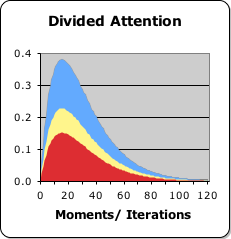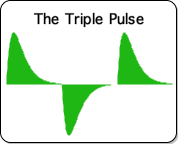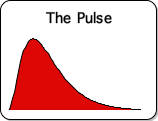Table of Contents
Baby Lorry & Information Dynamics (Nov 27, 2014)
Requirements for Life's Information Digestion System (Feb 22, 2015)
Dr. Gregory Hickok (May 25, 2015)
Clarence Proposal (May 26, 2015)
Posner Attention Model (Jun 7, 2015)
Divided Attention & Information Dynamics (June 24, 2015)
Mathematics of Attention (July 9, 2015)
Early History of Deregulation (August 5, 2015)
How Progressive is the US Tax System? (August 10, 2015)
History of Progressive Taxation (August 17, 2015)
Medicare Surcharge (August 24, 2015)
Social Security Myths (August 31, 2015)
Tribe vs. Empire (September 7, 2015)
Baby Lorry & Information Dynamics
Greetings friends,

Since my last transmission over a year ago, I have become a grandfather. Upon visiting my 6-month-old grandchild, I couldn't help but noticing how his 'raw' behavior regularly contradicted the standard scientific notions regarding human behavior and simultaneously confirmed the predictions of Information Dynamics.
Baby Lorry's curiosity indicates that he is much more than a reactive sack of mindless atoms. His craving for attention suggests that he is not merely a biological machine. Further his mysterious urges invalidate the notion that he is just a sophisticated computer that processes information.
Most of the standard theories regarding human behavior are founded on the notion that living matter is simply just that – 'matter'. Could it be that there is something other than matter that shapes and drives Baby Lorry's behavior? Is it possible that this tiny baby, less than 10 pounds, already has a mental component that is independent of and yet interacts with his physical side?

While Baby Lorry's behavior confounds the explanatory powers of the scientific community, his actions are totally in line with Info-Dynamics. Info-Dynamics is a cutting-edge mathematically-based theory of living behavior that introduces both meaning and choice into the scientific dialogue. In contrast to the standard theories that there is ultimately a material explanation for all phenomena, the exciting new theory of Info-Dynamics is committed to the notion that living matter is not just 'matter', but instead has an autonomous 'mental' component as well. Baby Lorry's behavioral patterns certainly provide evidence that confirms this seemingly radical theory.
For a more complete development of these ideas, check out the article Baby Lorry & Information Dynamics.
Let me know what you think. Comments, questions, suggestions, and critiques are always encouraged and welcome.
Regards, the madman commonly known as don
P.S. Please notify me if you don't want to receive these transmissions.
Life's Requirements for an Information Digestion System
Greetings friends,
Have you ever considered how we translate the impersonal digital information of 1s and 0s into personal knowledge that is relevant to our existance? For instance, how are we able to derive 'music' from our favorite CD? How is it that we dance wildly or cry uncontrollably when we hear a sequence of 1s and 0s that can't even touch each other? What is the translation process that bridges the infinite chasm between these 2 simple numbers?

I am excited to present a plausible theory that accounts for our personal connection to the impersonal digital sequences contained on our CDs, DVDs, computers and IPhones. The process that seems to enable connectivity is contained in a mathematical system labeled Information Dynamics. The theory concerns how living systems digest digital information to transform it into a form that is meaningful to Life. While the information processing epitomized by a computer is of necessity static, exact and fixed, living information digestion is of necessity dynamic, approximate and transformational. Think of the difference between a baby and a computer.

Our initial monograph illustrated some of the many patterns of correspondence between the mathematical processes of Information Dynamics and empirical reality. These include the harmful effects of Interruptions to the Creative Process, the negative impact of Sleep Deprivation, the Necessity of Sleep, and even the Biology of Sleep.
These striking correspondences evoke some distinct questions. Why does the mathematical model behave in similar fashion to experimentally verified behavioral and biological reality? Could these correspondences be a mere coincidence, some kind of odd artifact? Or perhaps the striking patterns are due to some yet as undiscovered molecular/subatomic mechanism? Or could these odd correlations between mathematical and living processes be due to the process by which living systems digest information?
We chose to explore the last theory. The first question we posed ourselves: What kind of information digestion process would a living system require? What are the entry level requirements? The highlighted article Life's Requirements for an Information Digestion System attempts to answer this query.
Regards, the madman commonly known as the don collection
P.S. Please notify me if you don't want to receive these transmissions.
Dr. Gregory Hickok
Salutations Dr. Gregory Hickok,
I was very excited to read your recent New York Times article entitled ‘It’s not a Stream of Consciousness’. Your fundamental example of the spinning bicycle wheel that appears to revolve in the opposite direction has puzzled me for quite some time. I was delighted to find that it is evidence that our mental processes are discretized rather than continuous.
The notion that the brain operates in a pulse-like, almost quantized, manner coincides with a mathematical model of information digestion that I have been developing for decades. In this context, the digestion process reveals the ongoing rates of change, i.e. derivatives, of data streams. In turn, the dynamics of information flows reveals the patterns that lie at the heart of meaning.
To better understand your novel perspective, I also read your article entitled ‘The Rhythm of Perception’ published in Psychological Science. The findings are extremely interesting to me. Quoting from the paper:
“Recent demonstrations of the tendency (a) for neural oscillations to entrain to rhythmic features of stimuli, (b) for intrinsic neural oscillation and stimulus phase to modulate attention and perception, and (c) for attention to be allocated in oscillatory pulses is consistent with an exceptionally broad neural mechanism for rhythmic entrainment that forms the foundation of sensation across species.”
Wow! It seems as if these mental rhythms are neither an isolated neural phenomenon, nor even species-specific.
These paradigm-changing statements raise questions for me. For instance, does the pulse-like nature of our mental processes apply to anything beyond the visual and auditory modes? How does the scientific community define attention? And does attention have a neurological basis?
In your discussion, you make the cryptic comment: “Similar findings have been reported in the visual domain, which indicates a general computational mechanism.” What form does this 'general computational mechanism' take? Is it only dealing with sensory input or do you envision it dealing with analytical or creative thinking as well?
Answers to any of these questions would be gratefully appreciated. Also, are there any articles that you might recommend I read on this subject or the general topic of brain waves?
Inspired by your work, I am currently writing a non-academic paper tentatively called 'Speculations on the Roots of Music'. Amongst other things, I am interested in trying to incorporate the ideas you present in "The Rhythm of Perception" in a general theory of Information Dynamics and will reference your work. I am writing the article for those who are curious about the potential connection between music and our cognitive processes.
With utmost respect, don lehman jr.
Clarence Proposal
Greetings Clarence,
I am honored to be included in your esteemed gathering and am excited to attend.
At the restaurant a few months ago, you mentioned that you could arrange for me to give a talk on my ideas if it could relate to music. You highly recommended the experience, even implying that it could lead to growth and transformation. Since then, two distinctly different topics have emerged that would both fit your criterion. Let me run them by you.
I'm about to write an article tentatively entitled 'Speculations on the Roots of Music: from both a Neurological and an Information-based Perspective'. Let me give you some background.
Serendipitously, Professor Hickok, a cognitive scientist at UC Irvine, wrote an article for the New York Times. He stated that recent neurological findings suggest that the brain operates in a pulse-like fashion, rather than continuously. If living systems digest information in a self-referential fashion, an assumption of Information Dynamics theory, then living experience should be pulse-like rather than continuous. Grateful and electrified by the congruence between my mathematically-based theory and scientific 'fact', I decided to contact the professor.
Unsure of the proper approach from an amateur scientist to a professional, I sought advice. By 'chance', one of my Tai Chi students is also a professor. She provided me with his most recent academic paper 2014. Accidently again, it happens to focus on establishing the pulse-like nature of our auditory cortex. He concluded by suggesting the obvious connection with music.
These apparent validations combined with recent insights into the intimate relationship between Music and Information Dynamics provide the inspiration for the upcoming paper. Then I thought 'Clarence'.
The second idea for a talk is totally different. The current scientific mindset is based in the 'either-or' perspective of visually-based set theory (inside or outside the box). Until the last decade or so, this was considered to be the only valid logical system and form for equations. Of recent, they have developed a hyperset theory that finally includes both an expanded notion of logic and iterative, i.e. self-referential, equations. The scientific community has shunned these 'disobedient' equations because of their general unpredictability.
'Disobedient' equations happen to be my specialty. In fact I argue that 'normal' equations are more applicable to material systems, while self-referential equations are more applicable to living systems. I further argue that self-referential equations have more to do with the 'logic of sound' rather than with the current 'logic of sight'. Sight is based in permanent objects, while sound is based in transitory information packets, i.e. pulses. Of course photons and electrons are more information packet than particle. Anyway, you can see where the article is headed - the referential logic of the info-packets of music.
A lot of ideas with plenty of time for refinement. Obviously seasons away from any kind of culmination. Thanks for your inspiration and consideration.
with affection, don the madman
Conserving Mental Energy (Posner Attention Model)
Greeting friends,
I am excited to share some recent findings regarding the conservation of mental energy and Information Dynamics.
Who wouldn't want to save energy? But mental energy?
To make sense of the many patterns of correspondence (list) between living behavior and the mathematical behavior of our information digestion system, we were 'forced' into making many assumptions. The existance of mental energy and its interaction with the material world was one of those assumptions.
If mental energy does exist, how does one conserve it?
The synergy between mathematics and empirical evidence suggests that focused (specific) Attention requires more mental energy than unfocused (general) Attention. It seems that we humans, at least, have a limited ability to move between general and specific attention. To save mental energy, we must reside in or return to the state of 'general attention' as frequently as possible.
How is this accomplished? Relaxing the mind and unfocusing attention.

These theories were formulated to make sense of the Sleepiness Phenomenon and Posner's Attention Phenomenon. For the justifications behind these bold claims, check out the just-finished article on the relationship between Information Dynamics and The Posner Attention Model. For a deeper understanding of this information-digestion based perspective, follow the green italicized glossary links.
Feedback is encouraged.
Regards, the don collection
P.S. Please notify me if you don't want to receive these transmissions.
Divided Attention & Information Dynamics
Salutations from the cyberworld,

Have you ever wondered why we have a hard time concentrating on a task or conversation when we are in pain or worried about the future? Could it be that our molecules or neurons are fighting with each other? Is it perhaps a random occurrence without any significance? Or is it possible that this negative impact upon Attention is related to the way we digest information?
If the last is true, the graph at the right demonstrates how dividing our Attention diminishes our ideal potentials. For a more thorough development of this topic, check out the recently posted article Divided Attention & Information Dynamics.
Feedback is encouraged.
Regards, the neural collection called don
P.S. Please notify me if you don't want to receive these transmissions.
Mathematics of Attention
Greetings Clarence,
Hope things are well with you and Birgit.

I'm excited to provide you with a link to an article I just finished called the Mathematics of Attention. It accomplishes a few tasks. The article begins by introducing the Living Algorithm, a procedure that digests information streams to reveal the dynamics of the moment. Following is a discussion regarding the innate differences between this reflexive system and standard set-based mathematics. It concludes by proposing a simple formula linking Attention, Experience, Information and Knowledge and then exploring some testable predictions.

The entire system is based around mathematical Pulses, the basis of music (another article).
Hope your busy schedule provides you with a little time to at least scan the article. Any feedback is greatly appreciated.
With deep affection for the motivation and friendship you have provided,
the collection of neural networks commonly referred to as don
Greetings all,
I'm excited to provide you with a link to an article I just finished called the Mathematics of Attention. It accomplishes a few tasks. The article begins by introducing the Living Algorithm, a procedure that digests information streams to reveal the dynamics of the moment. Following is a discussion regarding the innate differences between this reflexive system and standard set-based mathematics. It concludes by proposing a simple formula linking Attention, Experience, Information and Knowledge and then exploring some testable predictions.

As you might have already intuited, this article is written for those with mathematical inclinations. Hope your busy schedule provides you with a little time to at least scan the article. Any feedback is greatly appreciated.
Regards, the collection of neural networks commonly referred to as don
P.S. Please notify me if you don't want to receive these transmissions.
The Early History of Deregulation
Greetings,
My Muse impelled me to share an article that I have recently completed - Early History of Deregulation & the Beginning of Laissez Faire Economics. It is a fascinating and dynamic story.
The paper begins with John Law's Mississippi Bubble that almost bankrupt the French economy. The Mississipi Bubble, presumably the world's first Ponzi scheme, was based upon unregulated speculation in American real estate and founded upon the deregulation of the French banking system.
Drawing upon these disastrous experiences, Richard Cantillon, Law's partner, wrote the first modern economic treatise. Inspired by this treatise and his experience with Chinese wu wei, Francois Quesnay formulated the first treatment of laissez faire capitalism, even coining the term. He called it the 'natural system.'
He and his followers, the physiocrats, then convinced the French government to deregulate the French grain market to raise money. This led to wide spread starvation in the peasant class. Another of his followers persuaded the French king to eliminate trade barriers with England. This led to widespread rioting amongst the guilds. Both of these factors contributed to the French Revolution, when the aristocracy was overthrown.
Enjoy this tale of unbridled greed and unrestrained speculation.
Best regards, the human impetus to share known as don
P.S. Any feedback is welcome and greatly appreciated. Please notify me if you don't want to receive these transmissions.
How Progressive is the US Tax System?
Greetings,
It aggravates me to read the misinformation campaign of the Mass Media with regards to economics. To mitigate the anger gnawing away at my soul due to this blatant propaganda unsupported by any substantiated analysis, my Muse impelled me to write a series of articles to dispel these Media myths.
The first myth is that deregulation is good for the economy. The question is whose economy? In the most recent transmission, 'The Early History of Deregulation', we examined the early history of deregulation and laissez faire capitalism. We saw the disastrous effects on the population – mass starvation, exploitation, and economic hardship. All of these factors contributed to the French Revolution. In contrast, the capitalists thrived, as they siphoned off what little wealth the commons had.
There is second Media myth that irks me: the wealthy are shouldering an unfair and excessive share of the Federal Tax burden and so their taxes should be reduced. The current article, Is the US Tax System really Progressive?, examines the progressivity of the US Tax System. Employing easy to read graphs, we see how the progressive Federal Income Taxes plus regressive Social Security Taxes minus Income Tax Writeoffs ultimately equals a Flat Tax upon the American citizenry. These facts stand in stark contrast to the image that the Media presents – i.e. the 'tax burden' of the wealthy necessitates relief.
The graphs make it easy to see that the wealthier sectors of society do pay an enormous amount of money in federal taxes. However, they have an exorbitant amount of disposable income left after taxes. Although those on the lower income rungs pay a much smaller amount in Federal Taxes, they have barely enough disposable income to pay for necessities.
Best wishes to all, the light shining in the darkness, commonly known as don
P.S. Any feedback is welcome and greatly appreciated. Please notify me if you don't want to receive these transmissions.
History of Progressive Taxation
Greetings,
Just as it angers me to hear and read about the 'tax burden of the wealthy', it infuriates me when the major Media blames the social safety net for the economic woes of a nation, whether Greece, Britain, Japan or the US. In similar fashion, I want to scream with rage when I hear the major TV networks and newspapers speak about 'class warfare' and throw about the term 'redistribution of wealth' in a perjorative fashion when any politician speaks about tax reform on even the most minimal levels. My underlying fury is based in the fact that those who have so much disposable income, as per the last article, are so unwilling to contribute to the overall health of the society that has given them so much and then justify their unmitigated greed as good.
Due to fluctuations in the global economy, government expenditures inevitably exceed tax revenues. Rising public debt then threatens the economic stability of the country or state. Politicians then propose 'austerity measures' to solve this supposed 'problem'. This 'austerity' entails cuts to social services, the elimination of government jobs, and reductions in public pensions. This solution has never worked and always undermines a nation's economy. Why?
The Great Depression of the 1930s threatened the very fabric of society. Although the most extreme, the Great Depression was another of the boom and bust cycles that have plagued America's capitalist system from the beginning. Unmitigated speculation produces a bubble of prosperity that inevitably pops. Maynard Keynes, arguably the most influential economist of the 20th century, proposed a method that would damp the extreme and destructive fluctations of this cycle. Nearly all the nations of the world's have adopted his proposal.
His solution to capitalism's boom-bust economic cycle is straight forward. Employ a social safety net to protect the consumer, who represent the economic health of a nation. This damps the bottom of the cycle. Fund this with progressive taxation, which also drains money employed for reckless speculation. This damps the top of the cycle. The US government successfully employed this system to mitigate the extreme economic fluctuations of capitalism's boom-bust economic cycle for over 40 years (1935-1979).
In the 1980s, Ronald Reagan, tool of the wealthy, nearly eliminated the progressive nature of our system and shifted the tax burden to the working class. It could be argued that the elimination of progressivity was a contributing factor to the Great Recession of 2007. We need to restore progressivity to our tax system for the health of the nation. Tax reform is the solution, not austerity measures.
For details, check out the next article in this series – History of Progressive Taxation.
Best wishes to all, the spark of light in the gloom, commonly known as don
P.S. Any feedback is welcome and greatly appreciated. Please notify me if you don't want to receive these transmissions.
Applauding the Medicare Surcharge
Greetings Questioners,
Just as the lack of progressivity in the US tax system aggravates me, the Medicare Surcharge is a source of a great joy. Exceedingly thrilling to me, this recent tax reduces the regressivity of our tax structure and provides me with hope for future tax reform. I applaud Obama for persuading enough legislators to pass the Affordable Health Care Law of which the Medicare Surcharge is part.
Prior to Obamacare, Investment Income, for instance rents, interests and stocks, were exempt from the Medicare Tax. Only those earning money from a paycheck or business were required to contribute to our health system of which Medicare is part. The bulk of Investment Income is funneled into the bank accounts of the wealthier segments of our society. As such, the working classes were required to fund a disproportionate share of this compassionate government service that provides health care for the elderly members of our country. With the passage of the Affordable Health Care Act, all members of society who earn money, whether rich and poor, are now required to pay their fair share towards the maintenance of the greater society.
The Medicare Surcharge is as a huge step towards tax justice. We can only pray that this type of reform is eventually applied to our Social Security taxes. The Surcharge has also added a decade to the solvency of national health care and is one reason that the US economy is in much better shape than the rest of the world. For details, read Applauding the Medicare Surcharge: A Step towards Tax Justice.
Best wishes to all, a gleam of hope, a.k.a. don
P.S. Any feedback is welcome and greatly appreciated. Please notify me if you don't want to receive these transmissions.
How America can afford Social Security
Greetings,
It aggravates me when I read that the Social Security System is running out of money. This notion is based upon a flawed cognitive framework. The Mass Media portrays the Social Security System as a mandatory Pension Fund for the Working Class. Outgo to Retirees exceeds contributions by Workers; so the System will 'go broke' in a few decades, goes the reasoning.
There are 2 major fallacies to this mindset. First, the Social Security System is much more than a Pension Fund. Social Security revenues are disbursed to anyone who can't work, for instance Children and the Disabled, not just Retirees. Second, the Social Security System was set up as a Social Program to provide an 'adequate income' for the elderly when they became to old to work. It was never based upon financial 'equity', as are other types of insurance or pension funds.
As such the Social Security System is not a Pension Fund, but is instead a Government Program designed to assist those who are unable to work through no fault of their own. Most Government Programs, whether agricultural, education, or military, are funded by Federal Income Taxes, which are levied on both Earned and Investment Income. Currently the Social Security Program is solely funded by taxes levied on Earned Income. Social Security Taxes are neither levied on income above $120K per year nor on Investment Income. In other words, the wealthier segments of our society contribute only a very small percentage of their income to assist those who are unable to work. The bulk of Social Security funds comes from the middle and lower income earners.
If the United States is a Tribe of Family, then everyone should contribute to the common good. Under the Tribal mindset, the solution to the Social Security shortfall is simple. There is no need to raise the Social Security percentage for the lower and middle income earners. Instead levy Social Security Taxes on all income equally, Earned and Investment. Place these funds in a general fund designed to provide security for the greater American Family. This is tax justice, as all income contributes to the greater good, not just the income of the Working Class. For a more detailed analysis of these issues, read the article – Why America can afford Social Security.

Screaming in the darkness, the collection of neural networks a.k.a. don
P.S. Any feedback is welcome and greatly appreciated. Please notify me if you don't want to receive these transmissions.
Tribe vs. Empire
Greetings,
The overseas militarism of the United States angers me. The horrific medical treatment of hundreds of thousands of veterans makes me cry. The erosion of social services due to the voracious appetite of the military industrial complex evokes rage. What do these diverse topics have in common?
Each are based in the complex of values associated with the Empire-building model of government. An integral feature of this malicious perspective is that there are two classes: the Ruling Class and the Working Class. Under this unfortunate mindset, the Ruling Class takes what it wants through military force and the Working Class provides the labor force. Further, the underclass is dispensable after they have served their function. As such, they must fend for themselves. The notion that the Social Security Program is running out of money emerges from the Empire-building mentality. The Ruling Class seems to feel no obligation to help out those who can no longer work through no fault of their own.
The Tribal/Family model of government stands in stark contrast. Under this perspective, the Nation/Tribe provides for the essential needs of each citizen and all citizens help out according to their abilities. Under the Tribal model, a flat Social Security Tax would be levied upon both the Earned Income of the Working Class and the Investment Income of the Ruling Class. Not only would the Social Security System have an abundance of assets, this additional tax revenue could reduce the budget deficit and better take care of the deserving citizenry.
The Tribal model emerged during the Paleolithic Era from the Hunter-Gatherer societies. The Empire-building model supplanted the Tribal Model during the ensuing Bronze Age, associated with military aristocracies accompanied by the subjugation of women. It could be argued that the founding the American Democracy marked the first reassertion the Tribal Model of government in the sense that there was and is an attempt to eliminate the class system. However, it has been a constant battle. Don't be tricked. Vote Tribe.
For the historical development of these polar ways of thinking, check out the article, A Brief History: Empire vs. Tribe.
Just some random sounds coming from a cave, the fool a.k.a. don
P.S. Any feedback is welcome and greatly appreciated. Please notify me if you don't want to receive these transmissions.
Floral Jewels Spring Show

Dear all,
I am writing to let you know that I will be participating in a wonderful show right here in my neighborhood of Santa Barbara. The show is the "Bead Elements and Design Show ". It will be held at the Fess Parker Resort Doubletree, 633 E Cabrillo Blvd. Show dates are Friday-Sunday, May 6-8. Hours are 10-6 daily. Admission is $10 dollars. However, I have included a free pass at the bottom of this email. For more information, go to the show website, beadelements.com or email, info@bedagio.com, 1-503-274-2222.
Many of you may already know that the June 2016, Contemporary Crafts Market in Pasadena has been cancelled. The November 2016 Pasadena Crafts Market will be happening as scheduled and I will be there. I will let you know if there are any future changes.
I hope you are all well and I look forward to seeing you again soon.
Best regards,
Laurie


* If you no longer wish to receive these notes, please reply remove.
